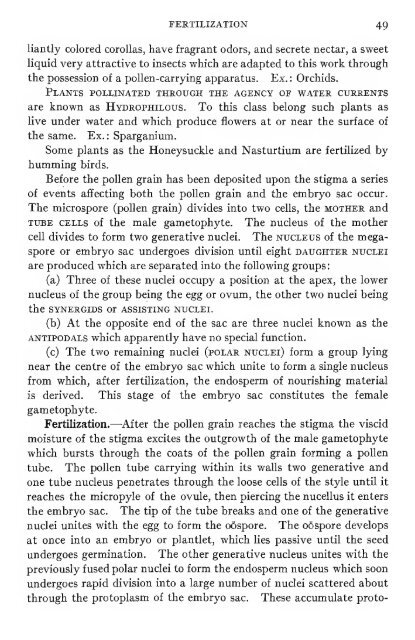Pharmaceutical botany - Lighthouse Survival Blog
Pharmaceutical botany - Lighthouse Survival Blog
Pharmaceutical botany - Lighthouse Survival Blog
You also want an ePaper? Increase the reach of your titles
YUMPU automatically turns print PDFs into web optimized ePapers that Google loves.
FERTILIZATION 49<br />
liantly colored corollas, have fragrant odors, and secrete nectar, a sweet<br />
liquid very attractive to insects which are adapted to this work through<br />
the possession of a pollen-carrying apparatus. Ex. : Orchids.<br />
Plants pollinated through the agency of water currents<br />
are known as Hydrophilous. To this class belong such plants as<br />
live under water and which produce flowers at or near the surface of<br />
the same. Ex. : Sparganium.<br />
Some plants as the Honeysuckle and Nasturtium are fertilized by<br />
humming birds.<br />
Before the pollen grain has been deposited upon the stigma a series<br />
of events affecting both the pollen grain and the embryo sac occur.<br />
The microspore (pollen grain) divides into two cells, the mother and<br />
tube cells of the male gametophyte. The nucleus of the mother<br />
cell divides to form two generative nuclei. The nucleus of the megaspore<br />
or embryo sac undergoes division until eight daughter nuclei<br />
are produced which are separated into the following groups<br />
(a) Three of these nuclei occupy a position at the apex, the lower<br />
nucleus of the group being the egg or ovum, the other two nuclei being<br />
the SYNERGiDS or assisting nuclei.<br />
(b) At the opposite end of the sac are three nuclei known as the<br />
antipodals which apparently have no special function.<br />
(c) The two remaining nuclei (polar nuclei) form a group lying<br />
near the centre of the embryo sac which unite to form a single nucleus<br />
from which, after fertilization, the endosperm of nourishing material<br />
is derived. This stage of the embryo sac constitutes the female<br />
gametophyte.<br />
Fertilization.—After the pollen grain reaches the stigma the viscid<br />
moisture of the stigma excites the outgrowth of the male gametophyte<br />
which bursts through the coats of the pollen grain forming a pollen<br />
tube. The pollen tube carrying within its walls two generative and<br />
one tube nucleus penetrates through the loose cells of the style until it<br />
reaches the micropyle of the ovule, then piercing the nucellus it enters<br />
the embryo sac. The tip of the tube breaks and one of the generative<br />
nuclei unites with the egg to form the oospore. The oospore develops<br />
at once into an embryo or plantlet, which lies passive until the seed<br />
undergoes germination. The other generative nucleus unites with the<br />
previously fused polar nuclei to form the endosperm nucleus which soon<br />
undergoes rapid division into a large number of nuclei scattered about<br />
through the protoplasm of the embryo sac. These accumulate proto-
















